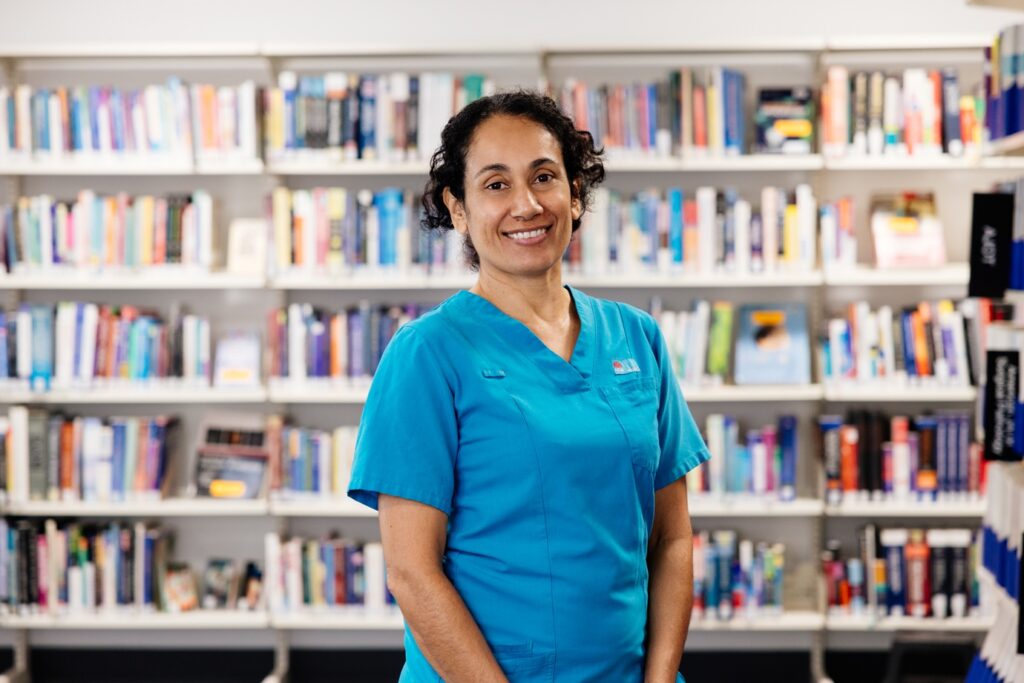As researchers develop cutting-edge breast cancer treatments, it’s vital that patients are properly supported to get the most out of these options.
That’s where supportive care comes into play. A breast cancer patient’s journey is deeply personal and coping with the side effects and psychological impacts of treatment cannot be overlooked.
Deep Inspiration Breath Hold (DIBH) is one fascinating area of research where supportive care is amplifying positive treatment outcomes.
Used during radiation therapy to move the heart away from the chest wall, DIBH is a technique for reducing the risk of heart damage. While the technique itself can make a huge impact in allowing for more targeted radiotherapy, a key part of its success is educating patients and supporting them to feel confident in tolerating DIBH.
Having seen many breast cancer patients struggle to tolerate DIBH, Kath Dower is a radiation therapist who is looking at how virtual reality could help them to learn the technique more effectively.
“The deep inspiration breath hold basically reduces dose to the patient’s heart and lungs,” she says. “It’s a more targeted treatment as well, because the patient’s chest is stationary through their treatment.”
“A lot of patients had problems with [DIBH], and so they weren’t able to be treated with [it] and many patients said to us that they had fear of the unknown. They were anxious about it all. They didn’t know what was going to happen,” said Dower, a 2025 clinical fellow with Breast Cancer Trials.
It was these observations that led Dower to seek solutions for her patients. As a 2025 clinical fellow with Breast Cancer Trials, her project is exploring whether Virtual Reality coaching and education can help patients learn DIBH.
The project was funded by the Cancer Institute NSW through the NSW Cancer Research Network.

Dower says that she and her team knew patients wanted something visual to help them learn the DIBH technique, and that’s why virtual reality offered the perfect solution.
“There’s heaps of research about the best way adults learn, and that’s visual, audio, readability and kinesiology,” Dower says, noting that as her team was looking into ways to incorporate these learning styles, a simple video wasn’t cutting it.
“We looked at TV videos, but then what we found was that people weren’t really focused on the [screen].”
When they tested virtual reality education, however, Dower says patients became completely immersed in the experience and better able to fully grasp the DIBH technique without as much anxiety.
“Basically, [patients] can’t look anywhere else, they have to be looking at that video, that experience that they’re in,” she says about virtual reality.
“So afterwards, the information that we received from patients was that it was wonderful. They knew exactly what they were doing. Their fear of the unknown was reduced. They knew what they needed to do.”
Dower and her team piloted an original virtual reality video that was about 12 minutes long, but as they’ve tested and fine-tuned the technology, it’s become about six minutes long, which helps keep patient’s attention spans more effectively.
The virtual reality allows patients to see an animation of a patient’s chest free breathing, while the patient practices taking a deep breath in. A radiation beam is shown to them as well, with a voice explaining what is happening- that their heart is moving away from the radiation beam. When they first start, the patient holds their breath for about 20 seconds, which increases incrementally with practice.
While some patients continue to struggle learning the DIBH technique even after using virtual reality, Dower is driven to support as many as possible and continue paving the way in supportive care for breast cancer.
“There’s definitely the reality that some people won’t be able to do it, even with a virtual reality and screening,” Dower says, noting that breath hold ability, anxiety, claustrophobia and a limited physical capacity following chemotherapy are all contributing factors.
She had one patient, for example, with a bad knee injury, who had pain go up her leg each time she took a breath practicing DIBH. Dower instructed the patient to see a physiotherapist beforehand to intervene with this pain and, after this intervention, she successfully completed her DIBH treatment.
Other patients have needed to take breaks during the DIBH technique due to their arms becoming sore when holding a still position. It’s these kinds of situations where patients have been able to get through by seeking support beforehand.
Many patients understand that the DIBH technique can be effective in lowering their risk of getting late cardiac events after their treatment, and this is why it can be incredibly frustrating when grasping the technique doesn’t come easily.
Nevertheless, despite whatever challenges a person’s individual circumstances present, Dower wants breast cancer patients to understand that there are vast networks of supportive care in this space, as well as new research developments happening all the time.
“The funny thing is that I didn’t know about a lot of research that was happening until I started my PhD, and then connecting with all these like committees and things like that- there is a lot happening,” she says.
“We need to get our research out there and make it accessible to as many patients as possible.”
Join Breast Cancer Trials on Wednesday 23rd July , from 5:30-7:00pm (AEST), for a free online Q&A, where a panel of experts will explore innovative new research (including Dower’s project) that is helping to reshape patient support and improve patient quality of life during breast cancer treatment. The session will be moderated by author and journalist Annabel Crabb. To register click here.

